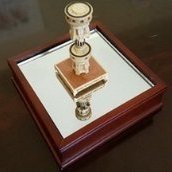-
Posts
3,867 -
Joined
-
Last visited
Reputation Activity
-
 KeithAug got a reaction from KORTES in Altair 1931 by KeithAug - FINISHED - Scale 1:32 - schooner
KeithAug got a reaction from KORTES in Altair 1931 by KeithAug - FINISHED - Scale 1:32 - schooner
More deck planking:-
I made a start on the planking which follows the contour of the deck edge. As explained previously these planks are much narrower. I made the planks .108 inch wide x 10 inch long which is 3.5 inch by 26 foot at full size.
It's probably worth posting a few images of the real thing at this point:-
I wanted the deck to be representative of the real thing but accepted that absolute accuracy wasn't quite achievable.
So here are a few images of progress to date:-
I was progressing well until my helper arrived and demanded some exercise!
-
 KeithAug got a reaction from KORTES in Altair 1931 by KeithAug - FINISHED - Scale 1:32 - schooner
KeithAug got a reaction from KORTES in Altair 1931 by KeithAug - FINISHED - Scale 1:32 - schooner
Deck planking complete - but as yet not sanded:-
A quick post this time consisting mainly of photographs.
Yesterday afternoon / evening and earlier today I completed the deck planking the initial photographs show where i started yesterday.
The accurate marking and positioning of the deck edge planks paid dividends and by the time I reach the deck centre line the symmetry was virtually spot on. No doubt an element of luck played its part.
Deck sanding tomorrow...........
-
 KeithAug got a reaction from Tecko in Altair 1931 by KeithAug - FINISHED - Scale 1:32 - schooner
KeithAug got a reaction from Tecko in Altair 1931 by KeithAug - FINISHED - Scale 1:32 - schooner
Deck planking complete - but as yet not sanded:-
A quick post this time consisting mainly of photographs.
Yesterday afternoon / evening and earlier today I completed the deck planking the initial photographs show where i started yesterday.
The accurate marking and positioning of the deck edge planks paid dividends and by the time I reach the deck centre line the symmetry was virtually spot on. No doubt an element of luck played its part.
Deck sanding tomorrow...........
-
 KeithAug reacted to pete48 in Altair 1931 by KeithAug - FINISHED - Scale 1:32 - schooner
KeithAug reacted to pete48 in Altair 1931 by KeithAug - FINISHED - Scale 1:32 - schooner
Very Nice Keith, She's going to be an Amazing Boat
Best Regards,
Pete
-
 KeithAug reacted to pete48 in Altair 1931 by KeithAug - FINISHED - Scale 1:32 - schooner
KeithAug reacted to pete48 in Altair 1931 by KeithAug - FINISHED - Scale 1:32 - schooner
Hi Keith, Coeur d' Alene is a beautiful part of the North West. The Deck is looking good. The way to add all references to your posting is done in the Signature. go to your profile page and hit the edit my profile button in the upper right corner, Then on the left side select signature, it will then display " my current signature" scroll down and in the edit signature, you can set it up however you like. I hope that helps
Best regards,
Pete
-
 KeithAug reacted to michael mott in Altair 1931 by KeithAug - FINISHED - Scale 1:32 - schooner
KeithAug reacted to michael mott in Altair 1931 by KeithAug - FINISHED - Scale 1:32 - schooner
Looking forward to the next step Keith.
Michael
-
 KeithAug reacted to Mirabell61 in Altair 1931 by KeithAug - FINISHED - Scale 1:32 - schooner
KeithAug reacted to Mirabell61 in Altair 1931 by KeithAug - FINISHED - Scale 1:32 - schooner
wonderful classic lines Keith,
a beautiful hull and very well built !
Nils
-
 KeithAug got a reaction from Nirvana in Altair 1931 by KeithAug - FINISHED - Scale 1:32 - schooner
KeithAug got a reaction from Nirvana in Altair 1931 by KeithAug - FINISHED - Scale 1:32 - schooner
Deck planking complete - but as yet not sanded:-
A quick post this time consisting mainly of photographs.
Yesterday afternoon / evening and earlier today I completed the deck planking the initial photographs show where i started yesterday.
The accurate marking and positioning of the deck edge planks paid dividends and by the time I reach the deck centre line the symmetry was virtually spot on. No doubt an element of luck played its part.
Deck sanding tomorrow...........
-
 KeithAug got a reaction from KORTES in Altair 1931 by KeithAug - FINISHED - Scale 1:32 - schooner
KeithAug got a reaction from KORTES in Altair 1931 by KeithAug - FINISHED - Scale 1:32 - schooner
Starting the deck planking:-
I decided to make the deck planking .045 inch thick. This is thicker than the previous build (Endeavour) which was circa .030 thick. The additional thickness should make the caulking easier.
The mahogany deck edge planks were glued in place taking great care to make sure they were equidistant from the centre line. It's really easy for the deck planking to become unsymmetrical about the centre line and this can look pretty bad.
I wanted something that looked like teak for the deck planks and the nearest thing I had were slats recovered from a broken wooden venetian blind. The deck planking is a bit unusual in design in that the centre line planks on the fore deck are greater in number than over the remainder of the deck. The centre line planks are also wider than the other deck planks. I decided to go for a width of 0.188 inch for the centre line planks which equates to a scale width of 6 inch.
I decided to caulk between the planks using .008 inch thick black card. This equates to a thickness of 1/4 inch which is about right fro deck caulking.
The caulking was accurately cut into strips .045 inch wide using a set up on the mill. This consists of a MDF board clamped to the mill table with a steel bar clamped into the chuck to form a guide. With the card taped to the MDF the steel bar is positioned a couple of thou above the card and this forms the back stop for the set square. The mill table is then indexed in .045 inch steps and at each step a strip is cut from the card using a craft knife.
The centre line planks are then glued in place - making sure they are symmetrical about the centre line. In the photos below you can see one of the caulking strips laid on the deck and the tail of one of the installed strips.
The centre line planks are now complete but at this stage not sanded.
The caulking effect looks pretty good.
-
 KeithAug got a reaction from Tecko in Altair 1931 by KeithAug - FINISHED - Scale 1:32 - schooner
KeithAug got a reaction from Tecko in Altair 1931 by KeithAug - FINISHED - Scale 1:32 - schooner
Thanks Pete
I stayed at Coeur d'Alene once on the way to visit the Scablands and Glacier NP. A nice part of the world.
Progress of a different kind!
Having glued the deck in place and strengthened the areas unsupported by frames (g clamps in photo), I thought I had better take stock.
For the deck edge planks I needed to cut .040" x .130" mahogany strips from a 40"x12"x7/8" former table top. This involved planing and sawing operations on my full size wood machines as well as sawing on the Byrnes saw using TCT and slitting saw blades. Multiple operations and setting on different machines is always something I am inclined to put off. This instance was no different and I found myself looking for something else to do. My diversion project started out as cleaning up the workshop (photos attached) but very quickly expanded into clearing out my tool draws. I set myself the challenge of throwing out all the tools that I couldn't remember having used in the last 20 years. It was quite a haul but I failed with a few items that I thought might come in useful some day!!! They will probably be thrown out by the kids when they come to sort out my affairs in another 20 years time. The up side though is that I discovered stuff that would be useful if I had only remembered that I had it.
Having exhausted all my diversionary jobs I made the 6 deck edge planks, yawn!
I have a question for all you experienced posters. I see that when you sign off your posts you frequently attach reference to all your past, ongoing an future builds. I assume that you don't type this stuff out every time and that somehow you have set it up automatically. How do you do this please?
Keith
-
 KeithAug got a reaction from Tecko in Altair 1931 by KeithAug - FINISHED - Scale 1:32 - schooner
KeithAug got a reaction from Tecko in Altair 1931 by KeithAug - FINISHED - Scale 1:32 - schooner
The sub deck:-
The various apertures for the chart house, skylights, hatches etc were cut out using a craft knife before
hacking the deck roughly to shape using the jigsaw. I left about 1/8 inch all round for final adjustment. A prolonged process of plane a bit, pin in place, check, remove, plane a bit more then ensued until I was happy with the fit. With the sub deck in place I drilled through it into the frames at multiple positions. As explained earlier the deck is concave longitudinally and convex across the beam. Some force is needed to hold the shape while gluing and the multiple holes will take the holding pins during in the gluing operation. The photos show the deck temporarily in place.
I mentioned in a previous post that the frames were spaced randomly on the plan and I had thought that this was for some greater purpose - to be revealed later in the build. It would have been sensible if the frames had been organised around the deck apertures but this wasn't the case - so the mystery of the random spacing continues.
With the deck temporarily in pace I marked the aperture positions on the frames and then removed the deck and cut the frames away with a razor saw. In one position I reinstalled an offset deck beam to support the deck. In two other positions I intend reinforcing the ply to compensate for local removal of the frames. I decided to install 2 oak blocks threaded and tapped (M8) to take the bolts for later installation of plank to handle the hull inverted for the 2nd planking operation. I find oak takes a thread well and shows no tendency to strip.
Finally I marked the edge of the deck on the line where the mahogany deck planks meet the teak planks.
Nothing to do now but glue the deck.
-
 KeithAug got a reaction from KORTES in Altair 1931 by KeithAug - FINISHED - Scale 1:32 - schooner
KeithAug got a reaction from KORTES in Altair 1931 by KeithAug - FINISHED - Scale 1:32 - schooner
Removal of up stands and a start on the deck:-
I had part cut the frames at deck level so removal of the up-stands wasn't a difficult process. I started by hand cutting but soon abandoned this in favour of a recently acquired multi tool fitted with a plunge blade. It worked a treat and I wonder why I hadn't bought one ages ago. I sanded the frames until I was comfortable with the deck profile which is concave bow to stern and convex across the beam. I used one of the left over planks laid across the frames to test the deck shape.
I decided to make the sub deck from 1/16 inch ply. Having cut a rectangular piece large enough to cover the hull I laid one of the long edges on the centre line of the hull and marked the position of the frames. I then drew the frame positions across the ply.
Having established the frame positions I used dividers to transfer the shapes of the deck cut outs from the plans on to the plywood.
Again using dividers I transferred the width of the hull on to the plywood at each frame position. The frames width dimensions were taken from the actual hull and not the plans.
I then used pins to give reference points against which a plank could be bent enabling the deck edge profile to be marked.
Having marked the deck profile I temporarily attached the plywood to the hull along the centre line.
I then marked the hull profile on the underside of the plywood using the hull as a template - thus checking the accuracy of the deck profile previously drawn. All was well.
Keith
-
 KeithAug got a reaction from tasmanian in Altair 1931 by KeithAug - FINISHED - Scale 1:32 - schooner
KeithAug got a reaction from tasmanian in Altair 1931 by KeithAug - FINISHED - Scale 1:32 - schooner
Deck planking complete - but as yet not sanded:-
A quick post this time consisting mainly of photographs.
Yesterday afternoon / evening and earlier today I completed the deck planking the initial photographs show where i started yesterday.
The accurate marking and positioning of the deck edge planks paid dividends and by the time I reach the deck centre line the symmetry was virtually spot on. No doubt an element of luck played its part.
Deck sanding tomorrow...........
-
 KeithAug got a reaction from Nirvana in Altair 1931 by KeithAug - FINISHED - Scale 1:32 - schooner
KeithAug got a reaction from Nirvana in Altair 1931 by KeithAug - FINISHED - Scale 1:32 - schooner
More deck planking:-
I made a start on the planking which follows the contour of the deck edge. As explained previously these planks are much narrower. I made the planks .108 inch wide x 10 inch long which is 3.5 inch by 26 foot at full size.
It's probably worth posting a few images of the real thing at this point:-
I wanted the deck to be representative of the real thing but accepted that absolute accuracy wasn't quite achievable.
So here are a few images of progress to date:-
I was progressing well until my helper arrived and demanded some exercise!
-
 KeithAug got a reaction from Elijah in Help my boat is bent !
KeithAug got a reaction from Elijah in Help my boat is bent !
Nicely done - you wouldn't notice unless told.
-
 KeithAug got a reaction from Andrea Rossato in Endeavour by KeithAug - FINISHED - Amati - Scale 1:35 - after 1989 restoration - J Class
KeithAug got a reaction from Andrea Rossato in Endeavour by KeithAug - FINISHED - Amati - Scale 1:35 - after 1989 restoration - J Class
Pondering Planking
At 1mm x 4mm (.040" x .160") the 1st planking strips are much thinner than those I have used for planking on previous models. I tend to use 1.5mm (.060") planks on large scratch built hulls. Also the spacing of the frames at circa 75mm (3") is greater than I would have desired. Reading previous posts and based on my own experience I was concerned that the planks would tend not to hold a smooth curve between frames and that sanding to achieve a smooth curve would lead to unacceptable thinning and lack of robustness in the finished hull. I didn't want to discard the kit planks so I decided to back the planks with balsa. A pack of 10 sheets of 12mm x 74mm x 450mm cost me £10 and this was sufficient for the whole hull. The next image shows the start of the process.
I mentioned in an earlier post that didn't follow the build instructions and that this gave me a problem. The Amati instructions suggest tacking the the thin plywood deck in place to hold the frames in shape while gluing. I didn't do this and ended up with the assembled frames having a lateral bow of 2mm. I think that following the instructions would have prevented this. Additionally the frames had about a 2 degree twist bow to stern. The deck offers little resistance to twisting and I don't think that tacking the deck in place would have helped prevent this. Using a solid building frame would have been the best option. However both problems were easily resolved by solidly bolting the assembled and glued frame on to a 25mm (1") thick piece of square and flat oak plank. Forcing the frame into the correct shape before completing the balsa backing layer. Once the backing layer was complete it formed a very rigid shell which held the frames in the correct alignment. The next 2 images show the oak "strong back" in place.
In retrospect I was very please that I had remembered to check the frame alignment while I still had time to do something about it!!!!!!
Having completed the backing layer, sanding was a relatively straight forward. I always try to use a sanding block and sand along the lines of the hull as I find this allows me to form a smooth transition of curvature. Feel is important when shaping the hull and I don't recommend the use of power tools for this operation. I try to get the shape generally correct without sanding down as far as the frames in the first instance. See photo.
As can be seen in the previous photograph the edges of the frames have been discoloured brown by the laser cutting operation. This forms a useful guide when finish sanding the backing layer, as once the discolouration is removed the hull has achieved its desired shape and its time for sanding to stop. See Images.
With the backing complete it was time to start the base planking. I found the oak strong back useful for holding the hull while working on it and I decided to retain it for the planking operation. I'll cover base planking in my next post.
-
 KeithAug got a reaction from Andrea Rossato in Endeavour by KeithAug - FINISHED - Amati - Scale 1:35 - after 1989 restoration - J Class
KeithAug got a reaction from Andrea Rossato in Endeavour by KeithAug - FINISHED - Amati - Scale 1:35 - after 1989 restoration - J Class
Drop Keel
A short post this time.
The Amati keel is 2mm (.080") thick 3 ply plywood with the outer layers being of mahogany. My keel had a 0.5mm ( 0.020") bow across the width. I decided to replace the supplied keel with one made of brass. I had a piece of brass plate to hand which was 3mm (.125") thick and I milled this down to the desired thickness. I then cut and filed it to shape using the supplied drop keel as a template. To achieve a mirror finish I hand finished with successively finer grades of wet and dry paper, finishing with 600 grit. The final polishing was done with Brasso (polishing compound).
I drilled and reamed a .250" hole in the keel and turned a pivot pin to a diameter of .2495" from brass rod. I machined a corresponding hole in the keel piece before glueing it in place. The following photographs illustrate the process.
-
 KeithAug got a reaction from AKRYPTO in Endeavour by KeithAug - FINISHED - Amati - Scale 1:35 - after 1989 restoration - J Class
KeithAug got a reaction from AKRYPTO in Endeavour by KeithAug - FINISHED - Amati - Scale 1:35 - after 1989 restoration - J Class
Having spent a number of years scratch building HMS Cornwall (Type 22 Frigate) at 1:96 scale I felt I wanted to tackle something a bit quicker and easier. I also wanted a model that provided the opportunity for enhancing the kit to create something a bit different from the norm. After a week or two trawling through the range of kits on offer I decided to build Amati's Endeavour at 1.35 scale. Although the kit features Endeavour in her 1934 guise I decided to model her as restored in 1989. To do this I have relied heavily on the web based photographic resources. The kit was a Christmas present from my kids and when finished my Daughter has claimed the model for her bay window.
The building of Endeavour has been covered in detail in a number of build logs and I don't intend going over the ground they have covered so well. What I intend doing is covering some of the things I have done differently and what I learned in the process.
I will start where I am now - in the middle of the build and then go back to the start, working through a series of updates over the next couple of months.
Hopefully with summer out of the way I will get back to building in September and complete in time to add another kit to my wish list for next Christmas.
Here are a few photographs to start the process.
-
 KeithAug got a reaction from aviaamator in Altair 1931 by KeithAug - FINISHED - Scale 1:32 - schooner
KeithAug got a reaction from aviaamator in Altair 1931 by KeithAug - FINISHED - Scale 1:32 - schooner
Thanks Pete
I stayed at Coeur d'Alene once on the way to visit the Scablands and Glacier NP. A nice part of the world.
Progress of a different kind!
Having glued the deck in place and strengthened the areas unsupported by frames (g clamps in photo), I thought I had better take stock.
For the deck edge planks I needed to cut .040" x .130" mahogany strips from a 40"x12"x7/8" former table top. This involved planing and sawing operations on my full size wood machines as well as sawing on the Byrnes saw using TCT and slitting saw blades. Multiple operations and setting on different machines is always something I am inclined to put off. This instance was no different and I found myself looking for something else to do. My diversion project started out as cleaning up the workshop (photos attached) but very quickly expanded into clearing out my tool draws. I set myself the challenge of throwing out all the tools that I couldn't remember having used in the last 20 years. It was quite a haul but I failed with a few items that I thought might come in useful some day!!! They will probably be thrown out by the kids when they come to sort out my affairs in another 20 years time. The up side though is that I discovered stuff that would be useful if I had only remembered that I had it.
Having exhausted all my diversionary jobs I made the 6 deck edge planks, yawn!
I have a question for all you experienced posters. I see that when you sign off your posts you frequently attach reference to all your past, ongoing an future builds. I assume that you don't type this stuff out every time and that somehow you have set it up automatically. How do you do this please?
Keith
-
 KeithAug got a reaction from Nirvana in Altair 1931 by KeithAug - FINISHED - Scale 1:32 - schooner
KeithAug got a reaction from Nirvana in Altair 1931 by KeithAug - FINISHED - Scale 1:32 - schooner
The sub deck:-
The various apertures for the chart house, skylights, hatches etc were cut out using a craft knife before
hacking the deck roughly to shape using the jigsaw. I left about 1/8 inch all round for final adjustment. A prolonged process of plane a bit, pin in place, check, remove, plane a bit more then ensued until I was happy with the fit. With the sub deck in place I drilled through it into the frames at multiple positions. As explained earlier the deck is concave longitudinally and convex across the beam. Some force is needed to hold the shape while gluing and the multiple holes will take the holding pins during in the gluing operation. The photos show the deck temporarily in place.
I mentioned in a previous post that the frames were spaced randomly on the plan and I had thought that this was for some greater purpose - to be revealed later in the build. It would have been sensible if the frames had been organised around the deck apertures but this wasn't the case - so the mystery of the random spacing continues.
With the deck temporarily in pace I marked the aperture positions on the frames and then removed the deck and cut the frames away with a razor saw. In one position I reinstalled an offset deck beam to support the deck. In two other positions I intend reinforcing the ply to compensate for local removal of the frames. I decided to install 2 oak blocks threaded and tapped (M8) to take the bolts for later installation of plank to handle the hull inverted for the 2nd planking operation. I find oak takes a thread well and shows no tendency to strip.
Finally I marked the edge of the deck on the line where the mahogany deck planks meet the teak planks.
Nothing to do now but glue the deck.
-
 KeithAug got a reaction from Nirvana in Altair 1931 by KeithAug - FINISHED - Scale 1:32 - schooner
KeithAug got a reaction from Nirvana in Altair 1931 by KeithAug - FINISHED - Scale 1:32 - schooner
Removal of up stands and a start on the deck:-
I had part cut the frames at deck level so removal of the up-stands wasn't a difficult process. I started by hand cutting but soon abandoned this in favour of a recently acquired multi tool fitted with a plunge blade. It worked a treat and I wonder why I hadn't bought one ages ago. I sanded the frames until I was comfortable with the deck profile which is concave bow to stern and convex across the beam. I used one of the left over planks laid across the frames to test the deck shape.
I decided to make the sub deck from 1/16 inch ply. Having cut a rectangular piece large enough to cover the hull I laid one of the long edges on the centre line of the hull and marked the position of the frames. I then drew the frame positions across the ply.
Having established the frame positions I used dividers to transfer the shapes of the deck cut outs from the plans on to the plywood.
Again using dividers I transferred the width of the hull on to the plywood at each frame position. The frames width dimensions were taken from the actual hull and not the plans.
I then used pins to give reference points against which a plank could be bent enabling the deck edge profile to be marked.
Having marked the deck profile I temporarily attached the plywood to the hull along the centre line.
I then marked the hull profile on the underside of the plywood using the hull as a template - thus checking the accuracy of the deck profile previously drawn. All was well.
Keith
-
 KeithAug got a reaction from Nirvana in Altair 1931 by KeithAug - FINISHED - Scale 1:32 - schooner
KeithAug got a reaction from Nirvana in Altair 1931 by KeithAug - FINISHED - Scale 1:32 - schooner
A little more progress..........
Having marked the waterline on the hull I realised my previous sequence had missed the vital step of making a building cradle. I had a look around the workshop and came across the discarded cradle from Endeavour. The fuller hull of Altair was fortuitous as a few quick cuts with the jigsaw transformed the cradle into one suitable for this build. (I used the frame templates from earlier to get the correct cradle profile).
With the hull finally the correct way up I set about the task of removing the building board. You may recall not all the frames were glued to the board and I had marked the glued frames so I knew where to cut.
While cutting away the building board I mused on the various removal stages and decided to name them for fun:-
1 THE AIRCRAFT CARRIER STAGE. (Illustrious class I think)
2 SAWING THE FAT LADY IN HALF STAGE. (Taking care not to get carried away)
3 THE CHINESE JUNK PHASE.
4 THE GALLEON PHASE (Forecastle still to be built)
Having removed all of the building board I started on the frames - the aft most frame removed to deck level.
-
 KeithAug got a reaction from Mfelinger in Altair 1931 by KeithAug - FINISHED - Scale 1:32 - schooner
KeithAug got a reaction from Mfelinger in Altair 1931 by KeithAug - FINISHED - Scale 1:32 - schooner
More deck planking:-
I made a start on the planking which follows the contour of the deck edge. As explained previously these planks are much narrower. I made the planks .108 inch wide x 10 inch long which is 3.5 inch by 26 foot at full size.
It's probably worth posting a few images of the real thing at this point:-
I wanted the deck to be representative of the real thing but accepted that absolute accuracy wasn't quite achievable.
So here are a few images of progress to date:-
I was progressing well until my helper arrived and demanded some exercise!
-
 KeithAug got a reaction from Nirvana in Altair 1931 by KeithAug - FINISHED - Scale 1:32 - schooner
KeithAug got a reaction from Nirvana in Altair 1931 by KeithAug - FINISHED - Scale 1:32 - schooner
Hi Mark
Yes the deck planking pattern is a bit unusual. I'm not sure why they would do it like that but it may just have been a consequence of the timber they had available in the ship yard.
Hello Pete
Altair is a beautiful yacht and I hope I do it justice.
-
 KeithAug got a reaction from Altduck in Help my boat is bent !
KeithAug got a reaction from Altduck in Help my boat is bent !
Nicely done - you wouldn't notice unless told.










